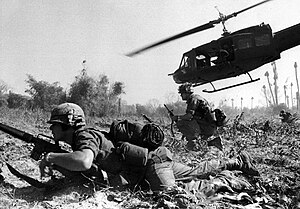Battle of Ia Drang
| Battle of Ia Drang Valley | |||||||
|---|---|---|---|---|---|---|---|
| Part of the Vietnam War (Operation Silver Bayonet I, Pleiku Campaign 1965) |
|||||||
 Some U.S. Army soldiers air assaulted into LZ X-Ray |
|||||||
|
|||||||
| Belligerents | |||||||
|
Supported by: |
|
||||||
| Commanders and leaders | |||||||
|
Harold G. Moore, 1st Battalion, 7th Cavalry Robert McDade, 2nd Battalion, 7th Cavalry Walter B. Tully, 2nd Battalion, 5th Cavalry |
Nguyễn Hữu An Phạm Công Cửu 66th Deputy Cmdr † Lã Ngọc Châu 7/66 Lê Xuân Phôi 8/66 † Nguyễn Văn Định 9/66 |
||||||
| Units involved | |||||||
|
3rd Brigade, 1st Cavalry Division (Airmobile):
2nd Brigade, 1st Cavalry Division (Airmobile):
|
|
||||||
| Strength | |||||||
| Total: ~1,000 cavalry troops Two batteries of artillery Separate aircraft and helicopter support units (740 bomber sorties and 96 B-52 sorties were flown) |
Total: ~2,500 troops |
||||||
| Casualties and losses | |||||||
|
American figures: LZ X-Ray: 79 killed and 121 wounded LZ Albany: 155 killed, 124 wounded and 4 missing LZ Columbus: 3 killed and 13 wounded Another 71 killed and 282 wounded in earlier actions 4 helicopters shot down, 55 damaged North Vietnamese estimate: 1,500 to 1,700 U.S. casualties |
American estimate: LZ X-Ray: Between 634 (body count) and 1,215 (estimated) killed and 4–6 captured LZ Albany: between 403 (body count) and 503 (estimated) killed, 2 captured (later executed). LZ Columbus: At least 27 killed North Vietnamese figures: 559 killed and 669 wounded |
||||||
| Both sides' estimates of their opponent's casualties are probably inflated. | |||||||
3rd Brigade, 1st Cavalry Division (Airmobile):
2nd Brigade, 1st Cavalry Division (Airmobile):
Total: ~2,500 troops
The Battle of Ia Drang comprises two main engagements conducted by the 1st Battalion, 7th Cavalry Regiment that took place on November 14–15, 1965 at LZ X-Ray ("eastern foot of the Chu Pong massif") and by the 2nd Battalion, 7th Cavalry Regiment on November 17 at LZ Albany further north in the Ia Drang Valley. It was the first major battle between the United States Army and the North Vietnamese Army-NVA (People's Army of Vietnam-PAVN) during the Vietnam War as part of the U.S. airmobile offensive code-named Operation Silver Bayonet I (October 23 – November 18, 1965). The battle was part of the second phase of a search-and-destroy operation code-named "Operation Long Reach" that took place from October 23 to November 26 during the Pleiku Campaign.
The battle derives its name from the Drang River which runs through the valley west of Plei Me, where the engagement took place (Ia means "river" in the local Montagnard language). Representing the American forces were elements of the 3rd and 2nd Brigades, 1st Cavalry Division (Airmobile): the 1st and 2nd Battalion, 7th Cavalry, and the 2nd Battalion, 5th Cavalry. Representing the North Vietnam forces were elements of the B3 Front of the NVA (including the 304th Division). The battle involved close air support by U.S. Army helicopter gunships and U.S. Air Force and U.S. Navy tactical jet aircraft, and a bombing attack by Air Force B-52s.
...
Wikipedia
